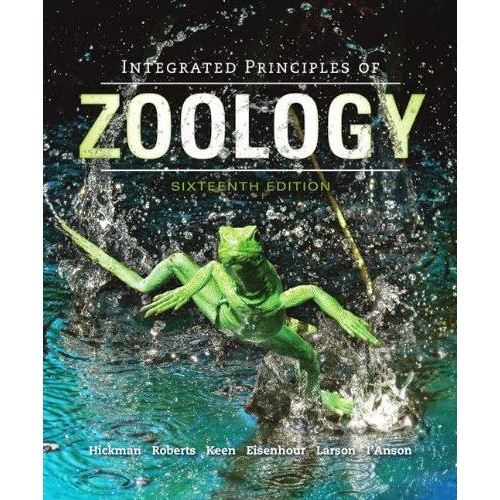Test Bank For Integrated Principles of Zoology 16th Edition Hickman-Keen-Larson-Roberts
Original price was: $65.00.$25.00Current price is: $25.00.
Digital item No Waiting Time Instant Download
Edition 16th Edition
Author Hickman
Copyright 2013
Publisher McGraw-Hill
ISBN-10 : 0073524212
ISBN-13 : 978-0073524214
Description
Test Bank For Integrated Principles of Zoology 16th Edition Hickman-Keen-Larson-Roberts
Chapter 03
Cells as Units of Life
Multiple Choice Questions
1. The Dutch microscopist who sent letters to the Royal Society of London describing his many detailed observations of life, including units later known to be cells, was
A. Anton van Leeuwenhoek.
B. Robert Hooke.
C. Matthais Schleiden.
D. J. Purkinje.
Accessibility: Keyboard Navigation
Bloom’s Level: 1. Remember
Gradable: automatic
Section: Cell Concept
Topic: Cell Concept
2. Which of the following is NOT true about the Cell Theory?
A. It states that all organisms are composed of cells
B. It states that all cells come from preexisting cells
C. It states that small organisms can arise spontaneously
D. It is accepted today by biologists as applying to virtually all forms of life
Accessibility: Keyboard Navigation
Bloom’s Level: 1. Remember
Gradable: automatic
Section: Cell Concept
Topic: Cell Concept
3. The surface of some parasitic flatworms and some insect tissues is a “syncytium” or living layer that contains many nuclei and cell organelles but is not partitioned by plasma membranes. These tissues consume food, respire, and produce wastes. Since the cell theory states that “all living things are composed of cells” what is the best statement to accompany this question?
A. These tissues are not living because they are not cellular
B. These tissues are obviously a bridge between nonliving and primitive living cells
C. The general concept of “life is cellular” still holds because these organisms still utilize cells sometime in their life, but this shows that plasma membrane partitions can be abandoned in some animals
D. This proves that a “vital force” beyond cell chemistry gives life to substances
Accessibility: Keyboard Navigation
Bloom’s Level: 4. Analyze
Gradable: automatic
Section: Cell Concept
Topic: Cell Concept
4. A high-powered microscope that produces a surface image from scattered secondary electrons is the
A. brightfield light microscope.
B. transmission electron microscope (TEM).
C. scanning electron microscope (SEM).
D. confocal microscope.
Accessibility: Keyboard Navigation
Bloom’s Level: 1. Remember
Gradable: automatic
Section: Cell Concept
Topic: Cell Concept
5. An important technique that allows biologists to trace the fate of chemicals in metabolic pathways is the use
A. of the immunofluorescence microscope.
B. of radioactive isotopes.
C. of time lapse photography.
D. of centrifugation.
Accessibility: Keyboard Navigation
Bloom’s Level: 4. Analyze
Gradable: automatic
Section: Cell Concept
Topic: Cell Concept
6. The current theory of the structure of the plasma membrane is best described by which of the following models.
A. The fluid-mosaic model
B. The unit membrane model
C. The electrochemical model
D. The nuclear envelope model
Accessibility: Keyboard Navigation
Bloom’s Level: 1. Remember
Gradable: automatic
Section: Organization of Cells
Topic: Organization of Cells
7. Major functions of the plasma membrane do NOT include
A. regulating molecules and ions that pass into and out of the cell.
B. recognizing and communicating between different cells and tissues.
C. maintaining connections between adjacent cells.
D. producing proteins used in construction of the cell.
Accessibility: Keyboard Navigation
Bloom’s Level: 2. Understand
Gradable: automatic
Section: Organization of Cells
Topic: Organization of Cells
8. In a phospholipid bilayer, the
A. Cholesterol is on the outside and plays a critical role in maintaining the fluidity of the membrane
B. Glycoproteins are on the inside providing a supporting site for adhesive functions
C. Glycoproteins are anchored in the plasma membrane to assist in their transport functions
D. Water-soluble ends are oriented toward the exterior and interior of the cell, whereas the fat-soluble fatty acids are oriented toward the inside of the membrane
Accessibility: Keyboard Navigation
Bloom’s Level: 1. Remember
Gradable: automatic
Section: Organization of Cells
Topic: Organization of Cells
9. Biologists label various carbohydrates, fats and amino acids with radio-isotopes, place them in a cell culture, and allow time for cell metabolism. Then by disrupting cells in a blender and separating out various cell organelles, they find the radioactive molecules can be detected as part of various cellular compounds although visible cell structures appear unchanged. Therefore
A. these “food” molecules are used only for energy.
B. most cell components are constantly being broken down and rebuilt.
C. molecules diffuse at random through the cytoplasm and into cell organelles.
D. radioactivity has an unusual role in metabolism of living cells.
Accessibility: Keyboard Navigation
Bloom’s Level: 2. Understand
Gradable: automatic
Section: Cell Concept
Section: Organization of Cells
Topic: Cell Concept
Topic: Organization of Cells
10. Which correctly describes ribosomes?
A. Ribosomes contain both DNA and protein
B. Ribosomes are active in carbohydrate synthesis
C. Ribosomal subunits leave the nucleolus and form ribosomes in the cytoplasm
D. Ribosomes are found associated with the endoplasmic reticulum in prokaryotic cells
Accessibility: Keyboard Navigation
Bloom’s Level: 2. Understand
Gradable: automatic
Section: Organization of Cells
Topic: Organization of Cells
11. Which is true concerning the Golgi complex?
A. It consists of a stack of membranous vesicles
B. Golgi complexes in animal cells have a forming face and a maturing face
C. Lysosomes are enzyme-filled vesicles that bud from the Golgi complex
D. All of the choices are correct
Accessibility: Keyboard Navigation
Bloom’s Level: 2. Understand
Gradable: automatic
Section: Organization of Cells
Topic: Organization of Cells
12. When water in a cell freezes slowly, sharp crystals spear through the membranes of the cell. The most likely explanation for the bad taste of meat that has “freezer burn” from repeated freeze/thaw cycles is the destruction of
A. the Golgi bodies and their vesicles.
B. lysosomes and resultant autodigestion.
C. rough endoplasmic reticulum causing the release of ribosomes.
D. the nuclear membrane causing mixing of nucleoplasm and cytoplasm.
Accessibility: Keyboard Navigation
Bloom’s Level: 3. Apply
Gradable: automatic
Section: Organization of Cells
Topic: Organization of Cells





Be the first to review “Test Bank For Integrated Principles of Zoology 16th Edition Hickman-Keen-Larson-Roberts”